Affiliate disclosure: This post may contain affiliate links. Please see our Privacy Policy.
Growing shiitake mushrooms is the perfect way to get started with homegrown mushrooms. Shiitakes are incredibly easy to grow, which makes them a perfect beginner’s mushroom.
For the more experienced mushroom cultivator, there’s often far more demand than supply, which means they’re a good addition to your farmer’s market table. A high price tag at the store means that growing shiitake mushrooms pays back quickly, especially since it only takes a small investment to get started.
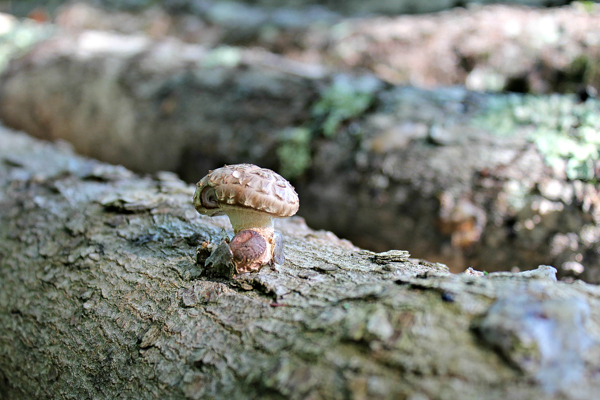
Growing Shiitake Mushrooms
Shiitakes produce best on oak logs, and their name actually means “mushroom of the oak.” Our swampy land doesn’t have any native oak trees, and we’re currently cultivating shiitakes on sugar maple thinned from our sugarbush.
While they may grow best on oak logs, they still produce great crops on a number of other types of log substrate. Shiitakes can also be grown successfully on sugar maple, hop hornbeam, alder, ash, beech, hickory, poplar and yellow birch.
If you just want the experience of watching them grow and develop, but you don’t have access to a woodlot, try a shiitake mushroom grow log. This is a great option for cultivating shiitakes indoors since everything is self-contained within the growing kit. It’s a great option for people that don’t have ready access to fresh logs.
If you do have access to fresh hardwood logs for shiitake cultivation, choose healthy trees that are free of disease and don’t show evidence of other mushroom colonization. For ease of handling, it’s best to choose relatively small trees, between 4 and 6 inches in diameter. If your woodlot is dense with small trees, thinning it for mushroom cultivation is a good use of the wood.
Cut the logs into 3 to 4-foot lengths to make them easy to handle and stack. Shiitake mushroom logs are often moved, soaked and stacked throughout their productive lifespan to induce fruiting. If you cut your mushroom logs too large, you’ll pay for it with a sore back over the roughly 8-year lifespan of each shiitake log.
Be careful to select logs with fully intact bark. The bark on each growing log will help retain moisture, which is essential for long-term shiitake production.
When logs quit producing early, most often it’s because the log dried out too much at some point in its lifespan. The only breaks in the bark should be the holes you drill to install dowel plugs, but then even those will be covered over with wax later to preserve moisture.
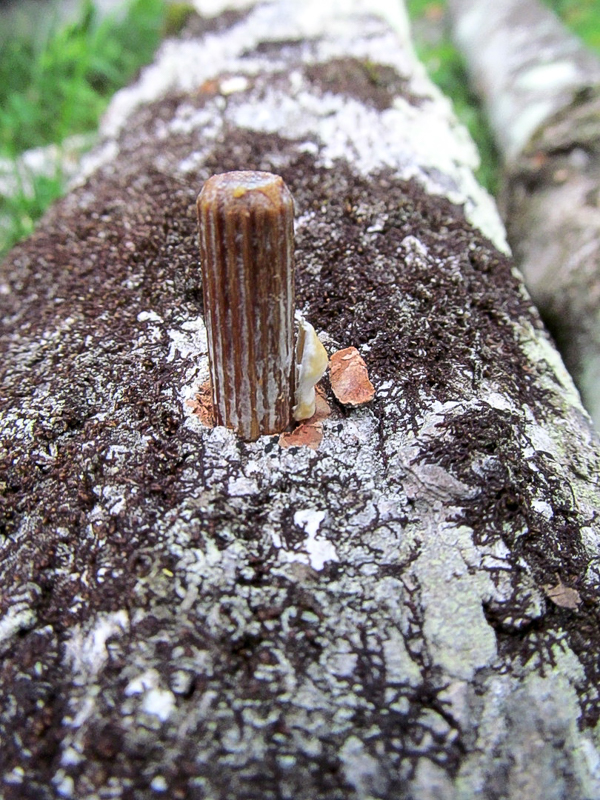
Selecting Shiitake Mushroom Spawn
Mushroom spawn is some type of substrate that has been colonized by mushroom mycelium. Generally, shiitake mushroom spawn is purchased as either plug spawn or sawdust spawn.
I’d recommend starting with plug spawn. It’s very easy to work use and requires few special tools. Plug spawn is small dowels that have been inoculated with shiitake mycelium.
Sawdust spawn is generally cheaper, but it’s a bit trickier to work with. A special inoculation tool is used to pack the sawdust into holes drilled in your mushroom logs.
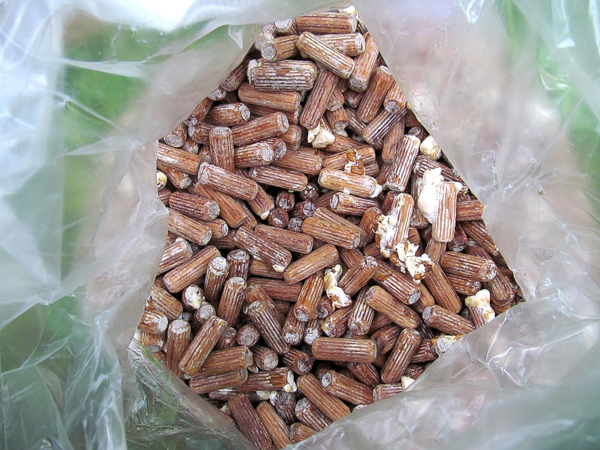
Supplies for Growing Shiitake Mushrooms
To grow shiitake mushrooms, you’ll need just a few things beyond hardwood logs and shiitake mushroom dowel plugs. If you’re starting with an indoor shiitake growing kit, everything’s already prepared for you. For the more hands-on grower hoping to put a substantial quantity of mushrooms on the table, you’ll need the following:
- 100 Shiitake Mushroom Spawn Plugs for every 2 or 3 logs
- Food safe wax such as cheese wax, beeswax or refined mushroom wax
- Hardwood logs (4 to 6 inches in diameter, 3 to 4 feet long)
- Daubers or a Paint Brush to apply wax
- 5/16-inch Drill Bit
- Drill Bit Stop Collar
- Cordless Electric Drill
For reference, I would highly recommend Tradd Cotter’s book, Organic Mushroom Farming and Mycoremediation. He covers every technical detail you’d need for growing just about any strain of cultivated mushroom. The best part is after he gives you all the super detailed science, he goes through it again in layman’s language, telling you how to do it all in your backyard with minimal tools and equipment.
How to Grow Shiitake Mushrooms
Growing shiitake mushrooms starts with inoculating hardwood logs. The first step is drilling holes to inoculate the logs with shiitake mushroom spawn.
For plug spawn, use a 5/16-inch drill bit to drill 1 inch deep holes. A stop collar attached to the drill bit makes drilling the correct depth easy as you work around your logs. (Sawdust spawn uses a 3/8-inch drill bit and holes 1 1/4 inch deep.)
A stop collar is important because it’s hard to drill holes to a precise depth consistently. If the holes are too deep, the extra space prevents the dowel plugs from effectively colonizing the log.
If they’re too shallow, the plug won’t fully seat into the log, which leaves them at risk for drying out. After you’ve drilled 100 or more holes in an afternoon, this extra investment of a few dollars for a stop collar is well worth it.
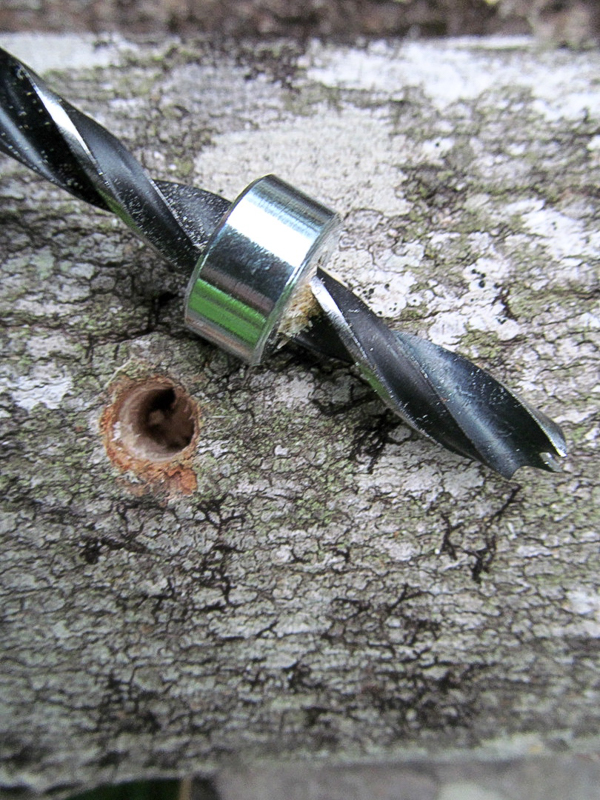
Holes are drilled at 10-inch intervals down the log, in rows about 2 inches apart. Stagger the rows using a diamond pattern. This helps to ensure that the entire log is colonized with mushroom mycelium.
While you could innoculate the logs more densely, this is the recommended amount to ensure full colonization without excessive waste. The most expensive part about growing shiitake mushrooms is the dowl plug spawn and overusing it drives up your costs.
Conversely, while over-inoculation can cost you extra money, under-inoculation can leave openings for competing fungus. It’s better to go a bit heavy-handed on inoculating shiitake logs than to cheap out and try to innoculate extra logs with insufficient dowel plugs.
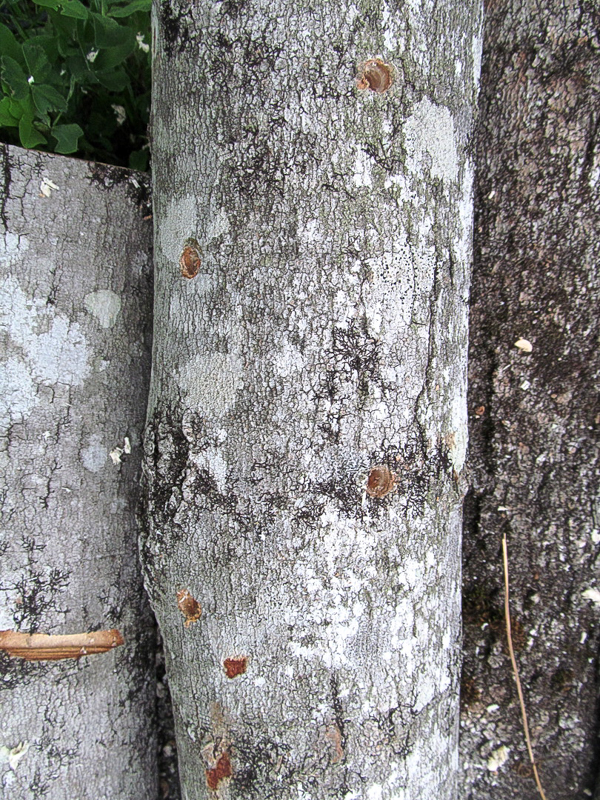
Once the holes are drilled, place a dowel plug in the hole and use a rubber mallet to gently tap it into place. A hammer works here too, just don’t apply more force than is actually necessary to tap the plug into the wood. Any extra damage to the bark will potentially cause drying which will hurt your shiitake crop down the road.
This is a great time to get the kids involved in growing mushrooms. Our 20-month-old daughter loved playing whack a mole with a rubber mallet and plug spawn, and then she was ecstatic to harvest the fruits of her labor the following year.
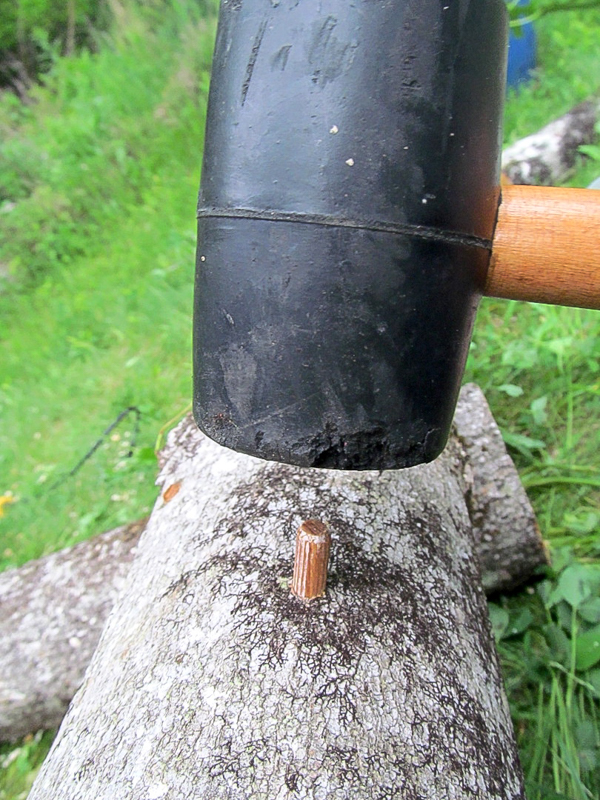
Though it’s not strictly required, most growers use a food-safe wax to seal the plugs and help hold in moisture. Even in a very wet climate up here in Vermont, we’ve still had trouble with logs drying out and quitting production long before their rated lifespan. Good choices are cheese wax, beeswax or specialty refined mushroom waxes that are sold by mushroom supply companies.
This kit comes with both shiitake mushroom plugs and mushroom wax, as well as daubers to apply the wax and tags to label the logs. It’s a good “all in one” place to start.
Some growers also seal both ends of the log with wax to help seal in moisture. This practice is a bit controversial since when you seal the ends it makes it harder for the log to absorb moisture.
If the logs do get too dry, you may not be able to fix it if you’ve sealed the ends. We don’t seal the ends, which allows for more flexibility when you need to water or soak the logs in dry years.
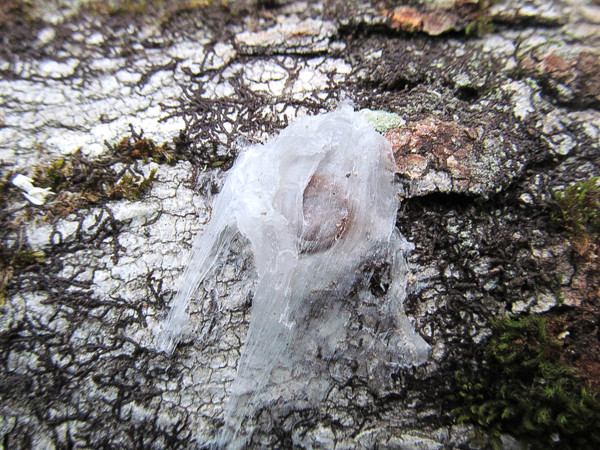
Tending Shiitake Mushroom Logs
Once you’ve inoculated your logs, they need to be kept sheltered from sun and wind which can dry them out. A low stack in a shaded area that you can reach with a hose is ideal. Like newly planted fruit trees, shiitake mushroom logs require about an inch of rain on average per week and should be supplemented with a hose during dry periods.
In dry areas, water the logs with a sprinkler weekly. This isn’t necessary if you have very regular rains. Our first year we were confident that we “always” get good rain during the summer months.
Of course, that year there was a record drought. Error on the safe side and stake the logs in an area that’s easy to reach with a hose.
If you’re in a particularly backwoods location without access to a hose, a body of water works well too. In dry times, the logs can be dropped into the water for a few hours to recharge their reserves.
Most of the year, shiitake mushroom logs can be kept stacked “log cabin style” to minimize their footprint. This allows you to fit more logs in a small space, and make it easy to keep the log stack watered during dry times.
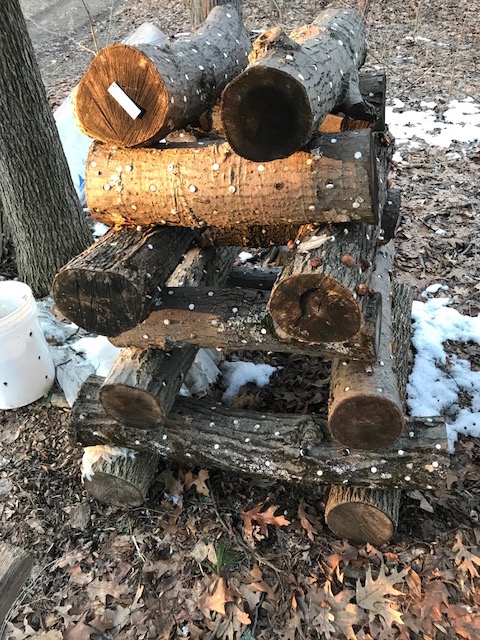
Shiitake Mushroom Pests
Before fruiting time, the biggest threat to a shiitake cultivation operation is drying out. Once fruiting begins, the concern shifts to predation by slugs.
Farming the Woods suggests employing a flock of backyard ducks to keep the slug population down, but when we raised ducks they devastated our landscape after heavy rains. They don’t eat the mushrooms, but they do eat just about everything else, from slugs to greenery, and they make an unholy mess of the muddy land after heavy rains.
A much more reasonable slug prevention tactic is circling the logs in a thick ring of wood ash. The slugs won’t cross a 3-4 inch wide ring of wood ash, as it’s basically made of leftover salts in the wood after burning.
Unlike table salt, it won’t hurt the soil or woodland ecology. Wood ash is a great natural slug prevention technique, but just be sure to re-apply after heavy rains.
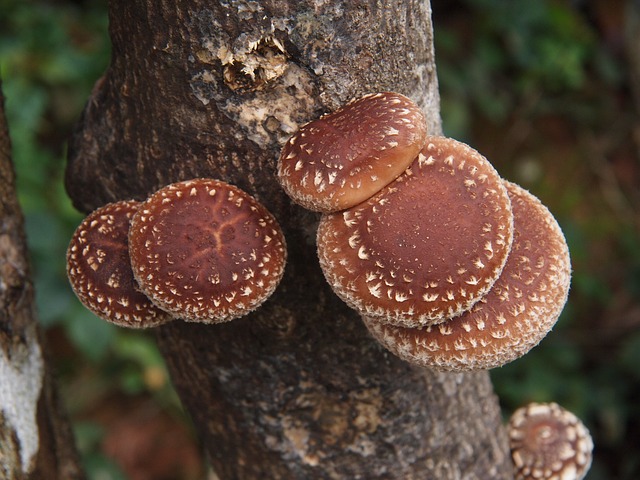
Harvesting Shiitake Mushrooms
Once the log is fully colonized with mycelium, you can induce fruiting by soaking the logs in a stock tank or giving them a whack. Either whack them with a heavy pipe or baseball bat or pick them up and drop them lengthwise onto their end.
The impact helps to stimulate the mycelium to fruit, and both soaking and impact are traditionally used in Japan. By soaking just a small portion of your logs each week, you can stagger harvests over a long fruiting season.
After the logs have been soaked, they’re leaned up against something so they can stand vertically. This allows more of the log to be exposed, which makes it easier to monitor and harvest the mushrooms. After the fruiting period ends, they’re stacked again into log cabin-like piles.
Once the mushrooms break the surface of the log, they can be gently broken off by hand. Mushrooms can be used fresh or dried in the sun on a screen for 2 days for long-term storage.
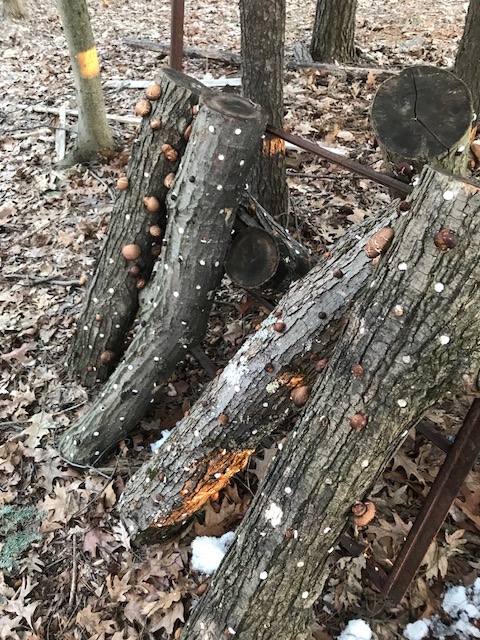
Shiitake Mushroom Yields
Shiitake mushroom logs will begin to produce roughly 8 to 16 months after inoculation. The specifics will depend on your climate. Each log will produce about a pound of mushrooms per year for up to 8 years.
Shiitake mushrooms sell for about $10 per pound locally, which means that each log should produce roughly $80 worth of mushrooms in its lifespan. A single bag of 100 spawn plugs costs about $10 can innoculate roughly 3 logs. That means a $10 investment (plus an afternoon of work) should result in roughly $240 worth of mushrooms.
Larger commercial operations bring their costs down further by using sawdust spawn and specialized inoculation tools. That said, the biggest cost for a producer is time.
The time waiting for the logs to produce, and the time moving, sorting and watering logs. For a backyard producer, your time is “free” if you’re doing this for fun and the profits can be eaten up at home in tasty harvests.
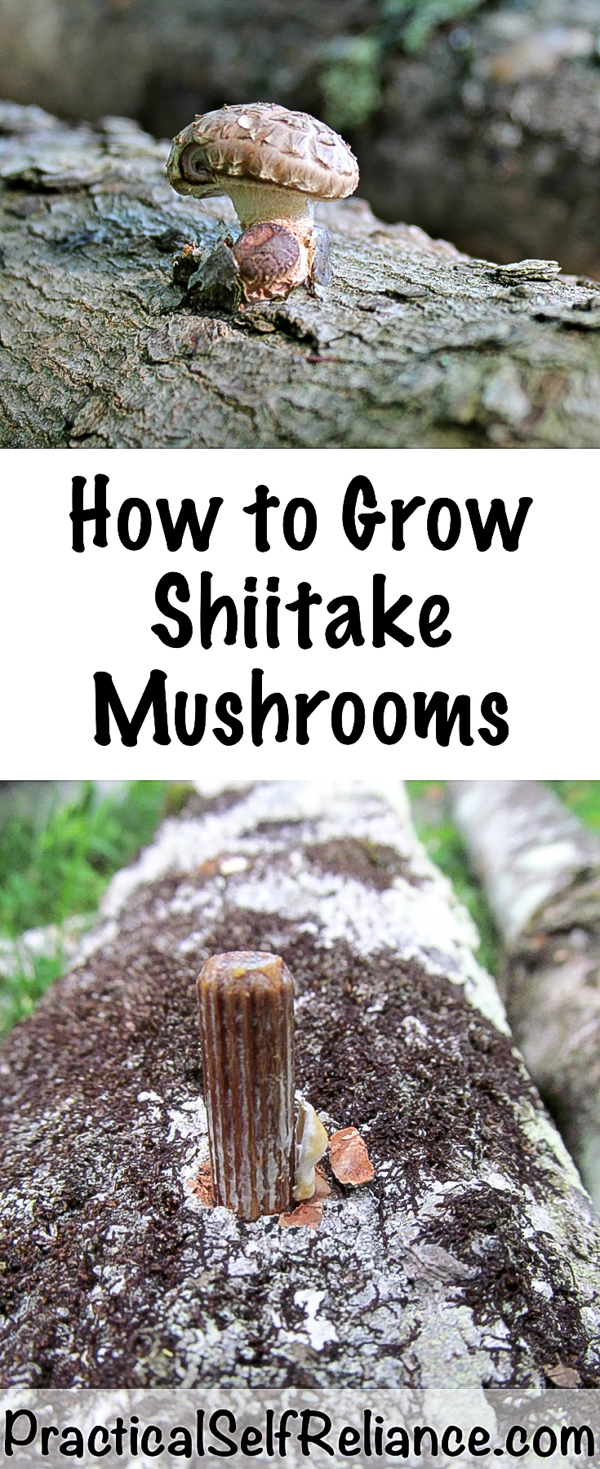

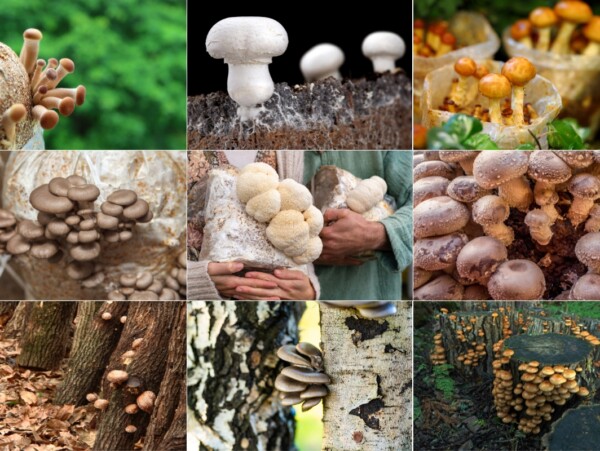
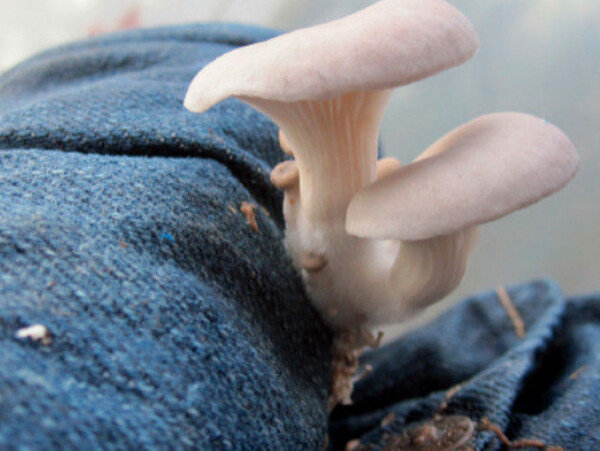
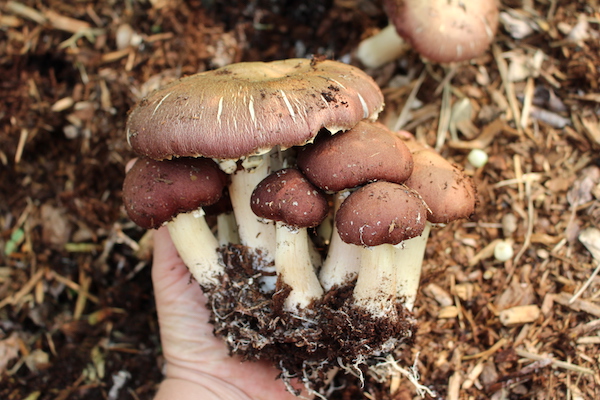










Hello there
I am truly grateful for your time and for the knowledge you share with all of us
So very excited about using this information to grow my own mushrooms
I love to garden, however arthritis has limited my ability to be on the ground, so after my hip replacement has healed I will be making raised garden beds this spring and I have the perfect place for my mushroom stack
Enjoy
Peace and love
That’s wonderful. Thank you for sharing. We’re so glad that you’re enjoying the blog. I’m sorry to hear about your arthritis but I’m glad you’re finding ways to get out there and do it anyway.
Hello, was wondering if the logs can be put in a corner of a green house as long as they are covered from the sun?
As long as the temperature and the humidity are correct.
Thank you
Hi Ashley,
Thank you for this post! I’m definitely using your blog as a reference for growing mushrooms, as well as for other things! I live in Massachusetts, so I have a similar climate to yours. When would you recommend that I get my plugs started by inoculating the logs? This is my first time growing mushrooms (or attempting to!) The instructions on the packet say I need six months of warm weather. I’ll be lucky if I get four months without a frost, but I’m not sure what “warm” means. Thanks for the help, and sorry if I missed an answer to this in your post or the comments.
The earlier that you can get them inoculated the better. It takes anywhere from 8 to 16 months for them to begin producing after inoculation depending on your climate.
Thank you for all this wonderful info! I live in coastal Texas. Do you think my logs can just hang out like yours do?
Honestly, I don’t know much about your temperatures, rain or humidity. I’d guess it’s a lot hotter, so keep them in the shade for sure. If you don’t get an inch of rain a week, they’ll need to be watered with a hose to mimic that once a week. Good luck!
I’m blown away to the amount of detailed tips and instruction in planting and growing your own mushroom at home. Thanks for sharing this.
Ashley
If I built a small room beside my house. And made a water misting system to water the logs. I could pull air from under my house during the summer to condition the the area. During the winter I would have to figure something else out.
My question is:
What Temp do I want to maintain as well as humidity for the Mushrooms? And do different types of mushrooms require different temps and humidities ?
Also can the logs be watered to much?
Thank you for your time and help,
Ron Ramsey
Glenn Allen, Virginia
You’re well over my head, and I don’t know the ideal temps/humidities for these. Ours are super low tech, just hanging out in the woods and they do well (at least in our climate).
Do you store your fresh-cut logs for a bit before plugging? I keep reading they should rest for several weeks before you plug them, to let them dry out a bit to kill any pre-existing fungi in them.
Oh, and also to allow the tree’s natural anti-fungal agents to dry up.
Theories are mixed on this. Letting them rest doesn’t kill existing fungi in them, just the opposite. It allows other fungi time to colonize. The reason to do this is to allow the natural enzymes in the wood to dissipate, things from a living tree (that are not present in deadwood) that would slow the growth of the mycelium. If you innoculate immediately, those compounds are still present because the tree was very recently living. Some suggest immediate inoculation anyway, as a way to prevent other things from infecting the wood ahead of the shiitake. Which way is better? I’m not sure, but just for practicality, we cut these in the winter and then didn’t get to innoculate them for a month or two. Worked out great.
Thank you for sharing the steps on how to grow our very own mushrooms. Bringing this alternative medicine closer and accessible to people who really need it. I hope that people will start to realize that the cure is always within our reach, it can even be in our own backyard.
I wanted to grow shiitake mushrooms the way it is, though it grows well in the wild here. Please suggest me the supplier for spawn in India or abroad.
I wish I could help you with a spawn supplier for abroad, but I honestly don’t know. I’d suggest contacting field and forest products, they’re really nice and if they can’t ship to you they may be able to help find someone who can.
Thanks for the lesson.I’m interested in growing the mushroom in Kenya but I don’t know what to do.
Good luck! We just harvested 4lbs today off 10 small logs that have been more or less ignored in the woods here in VT. I have no idea if it’s that easy in Kenya, but I wish you well.
How do you overwinter the logs? Leave them out in the snow? Tarp over them? Put them in the basement?
Just leave them out as is, laid low in a stack so that they’re under snow cover which insulates them from extreme cold.
Ashley,
My son gave me a Shitake mushroom log for Christmas 2018. I have already harvested my first batch of mushrooms. Awesome!
What do I do now? Let the log rest? Or continue to spray it for a 2nd harvest?
I think this will spur me to grow more on logs outside! So much fun.
Thank you in advance.
Hmmm…I don’t personally have any experience with indoor grow logs, but to the best of my knowledge, they’re just regular mushroom logs that have been stored until right before the first fruiting. It’s basically the same as a 1-year-old mushroom log, and you treat it the same and keep it in a cool moist area until it’s time for it to fruit again (the next year). That said, I have no idea if they stay productive year after year for 8+ years like a home inoculated log. Let me know how it goes!
Took a “Shiitake class” at a local arboretum a couple years ago. My wife and I each ended up with a single small log. We have gotten a lot more mushrooms than I ever thought out of those little guys. We just felled a tree this past weekend and will inoculate it in a week or 2. We should get 6 good sized logs from this tree.
Thanks for the information and wish us luck 😉
Dale
Wonderful Dale, good luck!
Hi Ash, does one plug produce 1 shroom, and you have to replug? and are the logs vertical until they are picked?
Why cant the grow in the log house configuration?
Also I have a ton of algea in my lake which I pulled so I can fish. Is this somthing I can grow shrooms in as there are a bunch of ones are growing out of in full sun …and I live in Florida -Thanks
Chris
They don’t produce a mushroom per plug, the plugs just inoculate the whole logs. The actual mushrooms will pop up all over the place and you should end up with a lot more mushrooms than the number of plugs you started with, especially over the life of the logs (several years). They’re kept in the house configuration to save space and to keep them low to the ground for storage so they stay moist, and so they’re insulated below the snow in cold climates during the winter. When you induce fruiting you put them upright so it’s easier to work all the way around the log, but that’s just for convenience in harvesting, it’s not mandatory.
Since you live in Florida, insulating under the snow isn’t really an issue, and from what I know y’all get plenty of rain for moisture. Just be sure to keep them in the shade out of the sun.
I’m not totally sure what you’re asking about the lake you mention, but Florida is a much different environment than Vermont, so I’m not sure I’d be the best to advise in this particular circumstance anyway.